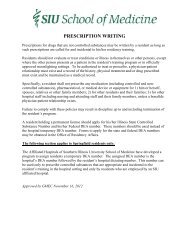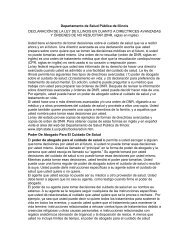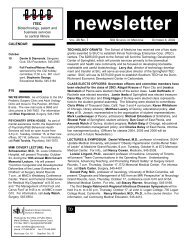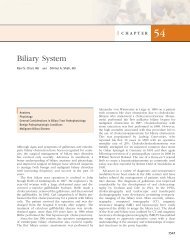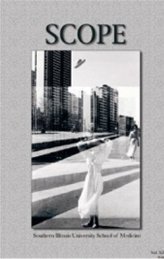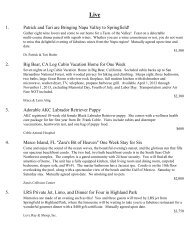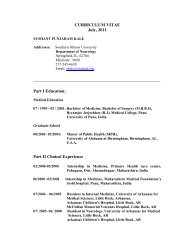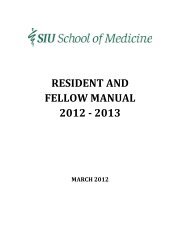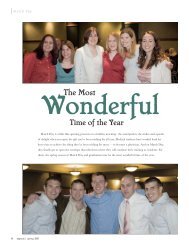- Page 1: ABOUT THE BIBLIOGRAPHY: A C A N T H
- Page 5 and 6: GM Burma Laos Viet Na Cambod Thaila
- Page 7 and 8: aaaaa-g- (1957) Gel'mintofauna diki
- Page 9 and 10: Dontsa, In: Materialy k Nauchnoi Ko
- Page 11 and 12: of Rio de Janeiro, Brazil) -abdal.2
- Page 13 and 14: (Pisces: Blenniidae) in NW Spain, B
- Page 15 and 16: Dagestane) -adilkh.1968a• Adiwina
- Page 17 and 18: Trudy IV konferentsii po prirodno-o
- Page 19 and 20: Ahluwalia, S. S. (1962) Studies on
- Page 21 and 22: akhme.1954b√ /Echinorhynchus gadi
- Page 23 and 24: Acanthocephala and Cestoda species
- Page 25 and 26: hirudinaceus Alekseev, V. M. (1970
- Page 27 and 28: Allely, Z., Janice Kay Moore and Ni
- Page 29 and 30: Arhythmorhynchus longicollis Alva-V
- Page 31 and 32: 1758) como reflexo do seu comportam
- Page 33 and 34: Fessisentidae) from Wisconsin fishe
- Page 35 and 36: host relationships of Pomphorhyunch
- Page 37 and 38: Neoechinorhynchus cylindratus /Lept
- Page 39 and 40: Dollfusentis bravoae /Dollfusentis
- Page 41 and 42: nigeriensis /N. ningalooensis /N. o
- Page 43 and 44: known acanthocephalans mostly from
- Page 45 and 46: Prosthorhynchus upupae /Prosthorhyn
- Page 47 and 48: Negro and Solimoes Rivers, in centr
- Page 49 and 50: Andreïko, Olga Fedorovna, Alekseï
- Page 51 and 52: obinsti, In: Raboty po Parazitologi
- Page 53 and 54:
Aguilar Aguilar, Rogelio, Guillermo
- Page 55 and 56:
Centrorhynchus teres /Gordiorhynchu
- Page 57 and 58:
South Africa, African Journal of Ec
- Page 59 and 60:
Araujo, J. L. de B., J. de A. Franc
- Page 61 and 62:
harengus pallasi Valenciennes): sur
- Page 63 and 64:
Asakawa, M., H. Okada, Y. Tsubura a
- Page 65 and 66:
Volga reaches) -astak.1966a√ /Pom
- Page 67 and 68:
obligatnom definitivnom khozyaine,
- Page 69 and 70:
Awachie, J. B. E. (1967) Experiment
- Page 71 and 72:
Polymorphus marilis /Polymorphus sp
- Page 73 and 74:
Nauchnoi Konferentsiï, Posvyashche
- Page 75 and 76:
Ed., Ylym, Ashkhabad: 118-121 pp,
- Page 77 and 78:
de Biologie 97:(24)604, -bacia.1927
- Page 79 and 80:
Cololabis saira from the Pacific Oc
- Page 81 and 82:
Bakay, Y. I. and A. V. Zubchenko (1
- Page 83 and 84:
magnus /Filicollis anatis Baldanova
- Page 85 and 86:
Bamidele, Akinsanya (2007) Histopat
- Page 87 and 88:
Bangham, Ralph Vandervoort (1955) S
- Page 89 and 90:
Barabashova, Valentina Nikolajevna
- Page 91 and 92:
Newfoundland, Journal of Fisheries
- Page 93 and 94:
arrf.1991a√ /Moniliformis monilif
- Page 95 and 96:
catulinus /Nephridiorhynchus major
- Page 97 and 98:
fauna of anuran amphibians (Amphibi
- Page 99 and 100:
Batchvarov, Georgi √Kh and N. M.
- Page 101 and 102:
Instutit 53, -bauero.1948f• Bauer
- Page 103 and 104:
Gel'mintologii) 26:125-142, (Result
- Page 105 and 106:
different concentrations of peat an
- Page 107 and 108:
Baylis, Harry Arnold (1951) The par
- Page 109 and 110:
Behnke, J. M., P. D. Harris, A. Baj
- Page 111 and 112:
Belofastova, I. P. (2004) Black Sea
- Page 113 and 114:
Kazakhstana, In: Gel'minty i gel'mi
- Page 115 and 116:
Pomphorhynchus laevis /Corynosoma s
- Page 117 and 118:
effect of Echinorhynchus borealis (
- Page 119 and 120:
Bergeon, P. (1965) Rapport au gouve
- Page 121 and 122:
the parasites of fishes from Austra
- Page 123 and 124:
of Acanthocephala in India, Punjabr
- Page 125 and 126:
Arhythmorhynchus, Zoologischer Anze
- Page 127 and 128:
intestinal epithelium of Muraenesox
- Page 129 and 130:
Moniliformis dubius Bird, Allen F.
- Page 131 and 132:
Blainville, Marie Henri Ducrotay, d
- Page 133 and 134:
401, -bobrov.1992a√ /Echinorhynch
- Page 135 and 136:
Ancystrodon halys (Reptilia, Crotal
- Page 137 and 138:
zones under ecosystem changes broug
- Page 139 and 140:
Acanthocephalus sp /Leptorhynchoide
- Page 141 and 142:
Bonfante, Rafael, Ernest Carroll Fa
- Page 143 and 144:
Tadzhikistana, Izvestiya Akademiï
- Page 145 and 146:
osca.1802a• /Echinorhynchus alcæ
- Page 147 and 148:
and comparison with other parasite
- Page 149 and 150:
zreli umaginalni formi na khelminti
- Page 151 and 152:
Brand, Theodor, von 1966) Biochemis
- Page 153 and 154:
Brattström, Hans (1941) Studien ü
- Page 155 and 156:
Universidad Nacional Autónoma de M
- Page 157 and 158:
Bremser, Johann Gottfried 1825) Sui
- Page 159 and 160:
Bristow, Gleln A., Tor Alvik and He
- Page 161 and 162:
Brown, Andrew F. and David Pascoe (
- Page 163 and 164:
Veterinary Journal 36:(4)113-117, -
- Page 165 and 166:
Buck, Owen D., C. Lawrence Cooper a
- Page 167 and 168:
Systematics, Biology and Ecology of
- Page 169 and 170:
Bullock, Wilbur Lewis (1957) Octosp
- Page 171 and 172:
ambiguus Van Cleave 1921 (Acanthoce
- Page 173 and 174:
Burmeister, Hermann 1848) Grundriss
- Page 175 and 176:
Bursey, Charles R. and Stephen R. G
- Page 177 and 178:
vodnej hydiny, Rada Veterinarni Med
- Page 179 and 180:
Metechinorhynchus lateralis Butorin
- Page 181 and 182:
Bychowski, B. E. (1962) Opredelite
- Page 183 and 184:
fauna) -bykhob.1936a√ /Pomphorhyn
- Page 185 and 186:
Cable, Raymond Millard and William
- Page 187 and 188:
Pomphorhynchus laevis Cakic, P., D.
- Page 189 and 190:
Camp, Joseph W., Jr., Laura M. Blan
- Page 191 and 192:
Canaris, Albert George and John M.
- Page 193 and 194:
Cardoso, S. B. (1980) Helmintos par
- Page 195 and 196:
Carvalho-Varela, M., M. V. M. Marco
- Page 197 and 198:
Riotton, S.A. 1-443, -cavall.1975a
- Page 199 and 200:
Chandler, Asa Crawford (1947) Notes
- Page 201 and 202:
pivnichnogo priazov'ya, Dopovidi Ak
- Page 203 and 204:
zone of the Ukrainian SSR) -cheba.
- Page 205 and 206:
Chernobaï, Vasiliy Fedotovich (19
- Page 207 and 208:
commercial marine animals. Series-M
- Page 209 and 210:
Gruzinskoï SSR, Materiali, 13-ï N
- Page 211 and 212:
(Procyon lotor) from southwest Brit
- Page 213 and 214:
choqu.1952a• /Tenuiproboscis serg
- Page 215 and 216:
Chubaryan, Flora Ambartsumovna (19
- Page 217 and 218:
domestic dogs from the middle Urals
- Page 219 and 220:
Clerc, Vladimir Onisimovich (1905)
- Page 221 and 222:
Echinorhynchus strumosus Cobbold, T
- Page 223 and 224:
acanthocephalan and a digenetic tre
- Page 225 and 226:
Conneely, J. J. and T. K. McCarthy
- Page 227 and 228:
52:(11)1421-1423, -coopec.1974c√
- Page 229 and 230:
moniliformis Cordero del Campillo,
- Page 231 and 232:
Costa, Graca, J. C. Eiras, J. Chubb
- Page 233 and 234:
Cox, Francis E. G. (1971) Parasites
- Page 235 and 236:
Thiere, in welchen Endozoen gefunde
- Page 237 and 238:
Crompton, David William Thomasson a
- Page 239 and 240:
Polymorphus minutus /Polymorphus pa
- Page 241 and 242:
Invertebrates, Adiyodi, K. G. and R
- Page 243 and 244:
the Island of Man, Reports of the M
- Page 245 and 246:
anguillae /Acanthocephalus lucii /E
- Page 247 and 248:
Bulletin, U.S. Department of Commer
- Page 249 and 250:
differential hemocyte counts in aca
- Page 251 and 252:
sp /Tegorhynchus sp /Cleaveius sp /
- Page 253 and 254:
of a workshop held in Cisarua, Bogo
- Page 255 and 256:
de Buron, Isaure and Yves Golvan (1
- Page 257 and 258:
ulbocolli /Neoechinorhynchus tumidu
- Page 259 and 260:
DeGiusti, Dominick Lawrence (1971)
- Page 261 and 262:
660 pp, -delya.1959a• Delyamure,
- Page 263 and 264:
(Helminth fauna of the ribbon seal
- Page 265 and 266:
Demidov, Nikolai Vasil'evich, A. V.
- Page 267 and 268:
74:(2)322-325, -devea.1988a√ /Mon
- Page 269 and 270:
Acanthocephaloides propinquus (Acan
- Page 271 and 272:
minutus (Acanthocephala), parasite
- Page 273 and 274:
Dhar, R. L. and V. K. Kharoo (1984)
- Page 275 and 276:
Centrorhynchus tumidulus /Deltacant
- Page 277 and 278:
practical reality?, In: Biology of
- Page 279 and 280:
Echinorhynchus cornicus /Echinorhyn
- Page 281 and 282:
Dill, William Thurman (1974) The li
- Page 283 and 284:
acanthocephalans from Bulgaria, Act
- Page 285 and 286:
Su river) -dobro.1963a√ /Neoechin
- Page 287 and 288:
laevis Dogel', Valentin Aleksandrov
- Page 289 and 290:
Dogel', Valentin Aleksandrovich and
- Page 291 and 292:
trématodes, cestodes et acanthocé
- Page 293 and 294:
hydrologiques sur la parasito-faune
- Page 295 and 296:
Neoechinorhynchus rutili /Neoechino
- Page 297 and 298:
Dronen, Normon O., Charles K. Blend
- Page 299 and 300:
Dubinina, Marina Nikolaevna (1949)
- Page 301 and 302:
ca nuoc ngot vung ngoai Thanh Ha No
- Page 303 and 304:
Dunagan, Tommy Tolson (1957) Studie
- Page 305 and 306:
nerves of Macracanthorhynchus hirud
- Page 307 and 308:
Dunglison, Robley 1893) Medical lex
- Page 309 and 310:
Duvernoy, George Lewis (1836) Vers
- Page 311 and 312:
utili Dyk, Václav and Zdenek Lucky
- Page 313 and 314:
nematodes and Macracanthorhynchus h
- Page 315 and 316:
Society of South Australia 116:(1-2
- Page 317 and 318:
33-45 pp, (Helminths of some rodent
- Page 319 and 320:
Neoechinorhynchidae) from the fresh
- Page 321 and 322:
intestinal helminths of dogs and fo
- Page 323 and 324:
Sary-Dzhazskikh syrtov, In: Gel'min
- Page 325 and 326:
Recruitment of helminth parasites b
- Page 327 and 328:
Espínola-Novelo, Juan Francisco an
- Page 329 and 330:
Evranova, V. G. (1954) Helminths o
- Page 331 and 332:
salinity gradient, Bothnian Bay Rep
- Page 333 and 334:
Farias, Jaime D. and Albert George
- Page 335 and 336:
Faust, Ernest Carroll and Corydon M
- Page 337 and 338:
Pomphorhynchus laevis Fei, A Chang
- Page 339 and 340:
North Carolina: host size and speci
- Page 341 and 342:
Ferreira, Luiz Fernando (1988) A pr
- Page 343 and 344:
Southwestern Naturalist 44:(4)522-5
- Page 345 and 346:
to the Skeena River, Bulletin - Fis
- Page 347 and 348:
Seriia Biolohichna 42:62-69, -fluen
- Page 349 and 350:
Southwellina hispida Forbes, John,
- Page 351 and 352:
1781) (Acanthocephala: Archiacantho
- Page 353 and 354:
of different wild birds from East A
- Page 355 and 356:
do Sul) -freire.1958a• /Macracant
- Page 357 and 358:
Frimeth, Jack P. (1987) Potential u
- Page 359 and 360:
Japonenses 12:(1)255-270, -fukua.19
- Page 361 and 362:
Polish Society of Parasitology of K
- Page 363 and 364:
promyslovykh ryb severo-zapadnoï a
- Page 365 and 366:
of helminthofauna of rodents and la
- Page 367 and 368:
Echinorhynchus sp Gállego Berengue
- Page 369 and 370:
Garcia, Renato George Gambin F., Mi
- Page 371 and 372:
Bolbosoma /Arythmorhynchus /Diplosp
- Page 373 and 374:
Note preliminaire, Revue Suisse de
- Page 375 and 376:
Gee, Randall Jarvis (1988) A morpho
- Page 377 and 378:
George, Panamthundil Varghese and A
- Page 379 and 380:
Chilena de Historia Natural 60:(2)1
- Page 381 and 382:
study of helminths of marine ducks
- Page 383 and 384:
Giard, Alfred (1904) L'Echinorhynch
- Page 385 and 386:
Gillet de Grandmont (1863) Echinorh
- Page 387 and 388:
da ocorrência de helmintos em anim
- Page 389 and 390:
Echinorhynchus ardeæ /Echinorhynch
- Page 391 and 392:
Cnemidophorus uniparens (Sauria: Te
- Page 393 and 394:
Goldberg, Stephen R., Charles R. Bu
- Page 395 and 396:
Hawaii, The American Midland Natura
- Page 397 and 398:
Goldberg, Stephen R. and Charles R.
- Page 399 and 400:
Golikova, M. N. (1960) Ékologo-par
- Page 401 and 402:
edescription de Pseudoporrorchis ce
- Page 403 and 404:
Palaeacanthocephala (Meyer, 1931) (
- Page 405 and 406:
note), Annales de Parasitologie Hum
- Page 407 and 408:
aspekty), In: Trudy Gel'mintologich
- Page 409 and 410:
Gorokhov, V. V. (1990) Problems of
- Page 411 and 412:
Echinorhynchidae), Acta Parasitolog
- Page 413 and 414:
Graber, Michel 1979) Bibliographies
- Page 415 and 416:
Echinorhynchus miliarius, Zenker, A
- Page 417 and 418:
Grimm, Oskar Andreevich (1870) Novy
- Page 419 and 420:
Gubanov, Nikolai Mikhailovich (195
- Page 421 and 422:
Guberti, V., S. Govini and M. A. de
- Page 423 and 424:
dynamics of endohelminths of Channa
- Page 425 and 426:
Gupta, N. K. and Mridula Jain (1980
- Page 427 and 428:
fishes of Arabian Sea, at Quilon, K
- Page 429 and 430:
Rivista di Parassitologia (50), New
- Page 431 and 432:
Echinorhynchus fusiformis /Echinorh
- Page 433 and 434:
Gvozdev, Evgeniï Vasil'evich (1962
- Page 435 and 436:
Ha, Ky (1964) Parasites of some fis
- Page 437 and 438:
Haley, Albert James (1952) Prelimin
- Page 439 and 440:
Leptodactylidae) in two contrasting
- Page 441 and 442:
Hammond, R. A. (1966) The proboscis
- Page 443 and 444:
Harada, Isokiti (1929) Ueber eine n
- Page 445 and 446:
Harms, Clarence Eugene (1959) Check
- Page 447 and 448:
Hartmann, S. and H. M. Hafez (1983)
- Page 449 and 450:
Hassanine, Reda M. El S. (2006) Aca
- Page 451 and 452:
Basin Naturalist 47:(2)259-275, -he
- Page 453 and 454:
Hemmingsen, Willy, I. Lombardo and
- Page 455 and 456:
truttae Herbst, Johann Friedrich Wi
- Page 457 and 458:
phocoena in Danish waters: a compar
- Page 459 and 460:
Acanthocephalus galaxii /Neoechinor
- Page 461 and 462:
North Dakota Academy of Science 7:1
- Page 463 and 464:
Hogans, William E., Michael M. Dads
- Page 465 and 466:
helminthoses, Magyar Allatorvosok L
- Page 467 and 468:
Moniliformis dubius (Acanthocephala
- Page 469 and 470:
inexpectatus /Rhadinorhynchus prist
- Page 471 and 472:
Hoshina, T., Syuzo Egusa and Y. Shi
- Page 473 and 474:
Hristovski, Nikola D., S. Stojanovs
- Page 475 and 476:
from the larvae of Ambystoma opacum
- Page 477 and 478:
St. Lawrence Watershed, In: A Biolo
- Page 479 and 480:
Iannacone, Jose A. and Jose Luis Lu
- Page 481 and 482:
Ichihara, Atsuo (1964) Studies on A
- Page 483 and 484:
Echinorhynchus gigas /Echinorhynchu
- Page 485 and 486:
Ilmolelian, L. L. (1969) The occurr
- Page 487 and 488:
Iseki, Motohiro, Isao Kimata, Akihi
- Page 489 and 490:
Aleksandr Prokovevich Ed., Kiev, Iz
- Page 491 and 492:
Ivanov, V. P. (1969) Parazitofauna
- Page 493 and 494:
Konferentsii Parazitologov Ukrainsk
- Page 495 and 496:
Jackson, Jerome A. and Brent Bonner
- Page 497 and 498:
the Pakistan Congress of Zoology 21
- Page 499 and 500:
Jeacock, Anita (1969) The parasites
- Page 501 and 502:
carp-like fish (Cyprinus carpio, Ti
- Page 503 and 504:
Washington 36:(2)277-280, -johnsca.
- Page 505 and 506:
Johnston, Thomas Harvey (1910) List
- Page 507 and 508:
Johnston, Thomas Harvey and Stanley
- Page 509 and 510:
Science) 2:(2)111-114, -jongt.2001a
- Page 511 and 512:
136:285-292, -kabat.1961a√ /Echin
- Page 513 and 514:
endoparazitakh zhivotnykh v okrestn
- Page 515 and 516:
Pakistan Journal of Zoology 34:(4)3
- Page 517 and 518:
Kakacheva-Avramova, Denka (1973) Zo
- Page 519 and 520:
Kaletskaya, S. L. (1960) Parazitofa
- Page 521 and 522:
marine fishes (6), Monthly Report o
- Page 523 and 524:
southern Amami, Japan, Kiseichugaku
- Page 525 and 526:
Karasev, Nikolai Filippovich (1970)
- Page 527 and 528:
Veterinariï, Belorusskoï SSR 10:1
- Page 529 and 530:
Kasták, Vendelin (1956) Predbezná
- Page 531 and 532:
Kaufman, Z. S. (2000) Akantotsefaly
- Page 533 and 534:
Kazic, Danilo M., Midhat Cancovic a
- Page 535 and 536:
Parasitology 65:(2)283-294, -kennec
- Page 537 and 538:
Kennedy, Clive R., D. D'A. Laffoley
- Page 539 and 540:
Kennedy, Clive R. (1998) Aquatic bi
- Page 541 and 542:
Kessler, Karl Theodor 1870) Über E
- Page 543 and 544:
4)114-121, -khanaa.1971a• /Pallis
- Page 545 and 546:
(Acanthocephala: Quadrigyridae) fro
- Page 547 and 548:
Kharchenko, Vitaliï Ivanovich and
- Page 549 and 550:
(Acanthocephala of birds in the asi
- Page 551 and 552:
aeriolae /Arhythmorhynchus teres /A
- Page 553 and 554:
Mediorhynchus zosteropis Kholodkovs
- Page 555 and 556:
Kihara, Midori (1959) On some Acant
- Page 557 and 558:
dubius, Journal of Parasitology 53:
- Page 559 and 560:
kiraa.2005a• /Neoechinorhynchus r
- Page 561 and 562:
Pomphorhynchus laevis Kirkwood, Jam
- Page 563 and 564:
kliks.1974a√ Surg removal from il
- Page 565 and 566:
etardatus Dunn, Journal of the Hokk
- Page 567 and 568:
Vierteljahreschrift für Wissenscha
- Page 569 and 570:
Köhler, Rudolf (1888) Mode of inve
- Page 571 and 572:
study of helmintofauna of perch of
- Page 573 and 574:
Kondrat'ev, V. P.
- Page 575 and 576:
egulation of helminth populations i
- Page 577 and 578:
Korotaeva, V. D. (1971) K gel'minto
- Page 579 and 580:
micracanthus /Centrorhynchus alucon
- Page 581 and 582:
Kostylev, Nilolaï Nikolaevich (192
- Page 583 and 584:
kotel.1964a√ /Polymorphus magnus
- Page 585 and 586:
kovalii.1960a√ /Polymorphus magnu
- Page 587 and 588:
Kovaleva, A. A. (1963) Parazitofau
- Page 589 and 590:
Akademiï Nauk Gruzinskoï SSR 28:(
- Page 591 and 592:
Krapf, Kieth and Tommy Tolson Dunag
- Page 593 and 594:
Acanthocephalus anguillae /Acanthoc
- Page 595 and 596:
on Sakhalin) -kroto.1959a√ /Neoec
- Page 597 and 598:
Kuc, Iwona and Teresa Sulgostowska
- Page 599 and 600:
Kulachkova, Valentina Gennadievna
- Page 601 and 602:
Helminthologia (Bratislava) 8:289-2
- Page 603 and 604:
Polymorphus minutus /Metechinorhync
- Page 605 and 606:
Dumka: 56-64 pp, -kuran.1987a• Ku
- Page 607 and 608:
Kurashvili, Boris Epifanovich (1961
- Page 609 and 610:
definitive host) -kurba.1978b√ /S
- Page 611 and 612:
(Helminthofauna of sea gull type bi
- Page 613 and 614:
ten species of gobiid fishes (Actin
- Page 615 and 616:
Moniliformis moniliformis Lackie, A
- Page 617 and 618:
de classes, des ordres et des genre
- Page 619 and 620:
Lange, Henning (1970) Uber struktur
- Page 621 and 622:
Systematic Parasitology 70:(2)107-1
- Page 623 and 624:
Lavrof) /Echinorhynchus strumosus /
- Page 625 and 626:
pp, -leedl.1972a√ /Acanthocephalu
- Page 627 and 628:
Echinorhynchus hystrix Leidy, Josep
- Page 629 and 630:
Leong, Tak-Seng, Ahmad Safri and Be
- Page 631 and 632:
Le Roux, M. L. (1933) Parasitisme e
- Page 633 and 634:
(7)137-138, [ABST] -leuck.1872b•
- Page 635 and 636:
Acta Parasitologica 42:(2)92-96, -l
- Page 637 and 638:
... C. A. Rudolphi et la descriptio
- Page 639 and 640:
Lingard, Ann M. and David William T
- Page 641 and 642:
areolatus /Echinorhynchus aurantias
- Page 643 and 644:
ovicristatus /Echinorhynchus clavul
- Page 645 and 646:
Grund des von D. D. Pedaschenko ges
- Page 647 and 648:
(On regularities in geographic dist
- Page 649 and 650:
Liu, D. et al. (1991) Paratenic hos
- Page 651 and 652:
Logacheva, L. S. (1974) Gel'minty r
- Page 653 and 654:
Administration Technical Report NMF
- Page 655 and 656:
Lühe, Max (1905) Geschichte und Er
- Page 657 and 658:
Lunaschi, L. I. and F. Drago (1995)
- Page 659 and 660:
parasites: A comparative analysis,
- Page 661 and 662:
-lyaim.1933a√ General Lyaiman, Ed
- Page 663 and 664:
MacDonald, J. W. (1963) Mortality i
- Page 665 and 666:
Prosthenorchis lemuri /Prosthenorch
- Page 667 and 668:
348, (Contribution to our knowledge
- Page 669 and 670:
Machkevsky, V. K., Tamara Nikolaevn
- Page 671 and 672:
MacKenzie, K. and P. Abaunza (1998)
- Page 673 and 674:
MacNeil, Calum, E. Bigsby, Jamie T.
- Page 675 and 676:
Mahoney, Shane P. and William Threl
- Page 677 and 678:
Malakhova, Raisa Petrovna (1972) P
- Page 679 and 680:
Malewitz, Thomas D. (1956) Intestin
- Page 681 and 682:
animal helminths from the Far East,
- Page 683 and 684:
Acanthocephalus dirus /Acanthocepha
- Page 685 and 686:
Centrorhynchus milvus Ward, 1956 (P
- Page 687 and 688:
de l'Institut Fondamental d'Afrique
- Page 689 and 690:
coast of North America, Journal of
- Page 691 and 692:
Margolis, Leo, J. M. Goff, S. C. Jo
- Page 693 and 694:
Markevich, Aleksandr Prokof'evich (
- Page 695 and 696:
Markov, Georgiy Sergeevich, V. Z. T
- Page 697 and 698:
-markow.1933b• Markowski, Stanisl
- Page 699 and 700:
of Fisheries (1904), Washington, D
- Page 701 and 702:
martinef.1986a√ /Oncicola canis M
- Page 703 and 704:
conortus, E. caudatus, E. croaticus
- Page 705 and 706:
(Helminths, parasites of mammals (I
- Page 707 and 708:
iohelminth of domestic animals in U
- Page 709 and 710:
Georgia) [in Georgian] -matsa.1967a
- Page 711 and 712:
Phallodactylus lanei (Gekkonidae),
- Page 713 and 714:
Sonoran spotted whiptail (Cnemidoph
- Page 715 and 716:
McCahon, C. Peter, A. F. Brown, M.
- Page 717 and 718:
McDonald, Malcolm Edwin 1988) Key t
- Page 719 and 720:
Macracanthorhynchus hirudinaceus Mc
- Page 721 and 722:
Meek, E. R. (1993) Population fluct
- Page 723 and 724:
Mehlis, E. (1831) Anzeige der "Nova
- Page 725 and 726:
Turkey) -merdi.1963a• /Moniliform
- Page 727 and 728:
Messick, Gretchen A., Robin M. Over
- Page 729 and 730:
Reichs, Band 4, Abt. 2, Lief. 2, Le
- Page 731 and 732:
Prosthenorchis elegans Middleton, C
- Page 733 and 734:
Multicolloquy of Parasitology, Trog
- Page 735 and 736:
Miller, Donald Morton and Tommy Tol
- Page 737 and 738:
227 /Centrorhynchus californicus Mi
- Page 739 and 740:
Miroshnichenko, Anatoly Ivanovich (
- Page 741 and 742:
parasitological situation in the re
- Page 743 and 744:
Möller, Heino von and Kirsten Ande
- Page 745 and 746:
Venetae continentur, Sitzungsberich
- Page 747 and 748:
Virginia opossum Didelphis virginia
- Page 749 and 750:
Andracantha baylisi /Andracantha cl
- Page 751 and 752:
montro.1956a• /Macracanthorhynchu
- Page 753 and 754:
Moore, Janice Kay and David William
- Page 755 and 756:
Moravec, Frantisek and Ottó Sey (1
- Page 757 and 758:
Morya, Biologiya Morya, Kiev 45:42-
- Page 759 and 760:
Echinorhynchus truttae /Metechinorh
- Page 761 and 762:
Chubaryan 1981) Helminths and helmi
- Page 763 and 764:
mozgo.1966a√ Gives % infection -
- Page 765 and 766:
minus notorum. Icones, Part 2, Havn
- Page 767 and 768:
fish species (Labridae: Cheilininae
- Page 769 and 770:
Muroma, Eero (1951) A list of paras
- Page 771 and 772:
Octospinifer macilentus Muzzall, Pa
- Page 773 and 774:
21:(4)594-598, -muzza.1995c√ /Ech
- Page 775 and 776:
Nagasawa, Kazuya, Syuzo Egusa and K
- Page 777 and 778:
Biology (Kiev)> -naide.1970a√ /Ac
- Page 779 and 780:
Kenkyu 10:(1)58-68, [in Japanese]
- Page 781 and 782:
pseudemydis Near, Thomas J. (2002)
- Page 783 and 784:
Nelson, Bill, G. E. Cosgrove and N.
- Page 785 and 786:
Annuel Fonctions Technique Institut
- Page 787 and 788:
clapper rail, Rallus longirostris,
- Page 789 and 790:
novaezelandensis Nickol, Brent Bonn
- Page 791 and 792:
Nikishin, Vladimir Pavlovich and Ge
- Page 793 and 794:
3 [Parasitological research in Sibe
- Page 795 and 796:
pp., -nilza.1900a• Niphadkar, S.
- Page 797 and 798:
strumosus /Echinorhynchus tuberosus
- Page 799 and 800:
the Helminthological Collection of
- Page 801 and 802:
Obeng, Letitia E. (1965) The helmin
- Page 803 and 804:
morphometrics and reproduction of C
- Page 805 and 806:
Development in Nigeria. Vom, Septem
- Page 807 and 808:
Oku, Yuzaburo, Sumiya Ganzorig, Nar
- Page 809 and 810:
Oliva, Marcelo E. and Isabel Balló
- Page 811 and 812:
Olsen, Yngve H. and Daniel Merriman
- Page 813 and 814:
characters in Irish and English pop
- Page 815 and 816:
Orecchia, Paola, M. Bianchini, N. C
- Page 817 and 818:
Oshmarin, Petr Grigor'evich 1963) P
- Page 819 and 820:
Osmanov, S. O. (1963) K poznaniyu p
- Page 821 and 822:
Overstreet, Robin M (1968) Parasite
- Page 823 and 824:
production) -ozersk.1930a√ /Macra
- Page 825 and 826:
(Arhythmacanthidae: Paracanthocepal
- Page 827 and 828:
Paliza, N. M. A. (1954) Encuesta de
- Page 829 and 830:
Moniliformis moniliformis Panin, Vi
- Page 831 and 832:
Fessisentis vancleavei /Illiosentis
- Page 833 and 834:
Echinorhynchus inflatus /Echinorhyn
- Page 835 and 836:
Parukhin, Amur Makarovich (1968) Ge
- Page 837 and 838:
Acanthocephaloides chabaudi /Acanth
- Page 839 and 840:
of Azerbaidjan, In: Study of Helmin
- Page 841 and 842:
Pavlov, A. V. (1966) Tsesdody i ak
- Page 843 and 844:
sympatric top carnivores from the r
- Page 845 and 846:
Pereira, Joaber, Jr. and Luis Ferna
- Page 847 and 848:
Pérez-Ponce de Léon, Gerardo, Lui
- Page 849 and 850:
77:(6)542-549, -petersw.1991A√ /M
- Page 851 and 852:
worms) of Domestic and Wild Animals
- Page 853 and 854:
Petrov, ¥Yurii Filippovich and √
- Page 855 and 856:
sevani Petrushevskiï, G. K. and E.
- Page 857 and 858:
Pfister, T. A. (1991) Les parasites
- Page 859 and 860:
Pichelin, Sylvie and T. H. Cribb (1
- Page 861 and 862:
Acanthocephalus anguillae /Acanthoc
- Page 863 and 864:
2:(1)65-128, (Alergy in parasitism
- Page 865 and 866:
Pod'yapol'skaya, Vavara Petrovna, A
- Page 867 and 868:
Polozhentsev, P. A. (1976) Endomohe
- Page 869 and 870:
Popov, Nikolaï Petrovich (1960) Ge
- Page 871 and 872:
parazitocenologov. Tezisy Doklady,
- Page 873 and 874:
aurantiacum /Bolborhynchus brevicol
- Page 875 and 876:
Corynosoma semerme /Corynosoma stru
- Page 877 and 878:
Poynton, S. L. and B. R. Whitaker (
- Page 879 and 880:
Price, Emmett William (1926) A note
- Page 881 and 882:
Ceskoslovenska Parasitologie 3:109-
- Page 883 and 884:
River and Lake St. Clair, Michigan,
- Page 885 and 886:
provinces> [in Russian] -pugac.1990
- Page 887 and 888:
Quentin, Jean-Claude (1989) Prevale
- Page 889 and 890:
Radulescu, I. (1948) Contributiuni
- Page 891 and 892:
parasite fauna of the franciscana i
- Page 893 and 894:
Raisyté, D. I. (1982) Helminth inf
- Page 895 and 896:
150, -ranki.1945a√ /Pomphorhynchu
- Page 897 and 898:
Skrivter af Naturhistorie-Selskabet
- Page 899 and 900:
Rauque, Carlos A., Liliana G. Semen
- Page 901 and 902:
Annals and Magazine of Natural Hist
- Page 903 and 904:
Echinorhynchus sp Redkozubova, O. I
- Page 905 and 906:
Hydrobiologie und Planktonkunde (Su
- Page 907 and 908:
Reina, D., M. Habela, F. Serrano, C
- Page 909 and 910:
Gunther, del estado de Tabasco, Bio
- Page 911 and 912:
Ricci, Marcello (1985) A finding of
- Page 913 and 914:
Richardson, Dennis J. (2006) Life c
- Page 915 and 916:
de lenguados congenericos y syntopi
- Page 917 and 918:
phillippii (S.), Boletín de Lima 1
- Page 919 and 920:
obinse.1969a√ /Macracanthorhynchu
- Page 921 and 922:
Rodenberg, G. W. and Danny Bruce Pe
- Page 923 and 924:
de Biodiversidad 79:(1)159-173, (Th
- Page 925 and 926:
ohdek.1966b√ 1 acanth found Rohde
- Page 927 and 928:
Llyn Tegid (Bala Lake), North Wales
- Page 929 and 930:
Pomphorhynchus laevis Roman-Chiriac
- Page 931 and 932:
47:(1/2)13-18, -rosen.1986a√ /Neo
- Page 933 and 934:
Bangkok, National Resources Council
- Page 935 and 936:
Echinorhynchus capite et collo arma
- Page 937 and 938:
Moniliformis dubius Ruff, M. D. (19
- Page 939 and 940:
Rumyantsev, E. A. and S. E. Maslov
- Page 941 and 942:
Rutkowska, Maria A. (1980) The helm
- Page 943 and 944:
Ryzhikov, Konstantin Minaevich 1955
- Page 945 and 946:
Arhythmorhynchus frassoni /Mediorhy
- Page 947 and 948:
Zentralblatt für Bakteriologie und
- Page 949 and 950:
Sadijedi, Seyed Mahmoud (2002) A po
- Page 951 and 952:
Kavkaze v predelakh Azerbaydzhansko
- Page 953 and 954:
in Dagestan, In: All Union Conferen
- Page 955 and 956:
Salgado-Maldonado, Guillermo and N.
- Page 957 and 958:
(Acanthocephala: Plagiorhynchidae)
- Page 959 and 960:
papillosus Samedov, Garun Musaevich
- Page 961 and 962:
Sanmartín, M. L., M. F. Alvarez, D
- Page 963 and 964:
on the helminth parasites of fishes
- Page 965 and 966:
Sarmiento Bendezu, Luz (1954) Gigan
- Page 967 and 968:
species (Chondrostei: Acipenseridae
- Page 969 and 970:
Acanthocephala, In: Chemical Zoolog
- Page 971 and 972:
Schelhaas, Douglas P. (1980) Compar
- Page 973 and 974:
Schmidt, Gerald Dee (1965) Corynoso
- Page 975 and 976:
55:(2)329-334, -schmi.1969d√ /Cen
- Page 977 and 978:
Schmidt, Gerald Dee (1977) Oncicola
- Page 979 and 980:
Sitzungsbericht der oberhessischen
- Page 981 and 982:
Schram, F. R. (1991) Cladistic anal
- Page 983 and 984:
Scott, James S. (1985) Occurrence o
- Page 985 and 986:
Sekhar, S. Chandra and William Thre
- Page 987 and 988:
Sen, J. K. (1980) Collection and pr
- Page 989 and 990:
Sergienko, M. I. (1955) K parazito
- Page 991 and 992:
seyaa.1970a√ /Acanthocephaloides
- Page 993 and 994:
vodoplavayushchikh ptits v Azer'aï
- Page 995 and 996:
Universiteta 3:60-73, -shapk.2002a
- Page 997 and 998:
Sharpilo, Viktor Petrovich (1963) R
- Page 999 and 1000:
Helminths of the sand lizard, Lacer
- Page 1001 and 1002:
Veterinarnogo Instituta 10:13-24, (
- Page 1003 and 1004:
shevc.1965a√ /Acanthocephalus luc
- Page 1005 and 1006:
Shevtsov, Aleksandr Alekseevich, L.
- Page 1007 and 1008:
vodochranilishcha, Vsesoyuznogo Ins
- Page 1009 and 1010:
Shimalov, V. V. (2002) Helminth fau
- Page 1011 and 1012:
123 pp, (Helminths and helminthiase
- Page 1013 and 1014:
pigs north of Kazakhstan) -shola.19
- Page 1015 and 1016:
Azores archipelago banks, Parazitol
- Page 1017 and 1018:
244, (Parasitofauna of fishes of Si
- Page 1019 and 1020:
parasite fauna of poultry in Moldav
- Page 1021 and 1022:
vodokhranilishcha, Trudy Instituta
- Page 1023 and 1024:
Silva, Renato Zacarias and Joao-Car
- Page 1025 and 1026:
Sinisalo, Tuula and E. Tellervo Val
- Page 1027 and 1028:
Skírnisson, Karl, M. Eydal, E. Gun
- Page 1029 and 1030:
skryas.1975a√ /Bolbosoma turbinel
- Page 1031 and 1032:
volailles, Bulletin - Office Intern
- Page 1033 and 1034:
Neoechinorhynchus (Acanthocephala:
- Page 1035 and 1036:
Multisentis myrmecobius Smales, Les
- Page 1037 and 1038:
Akademiya Nauk SSSR: 128-145 pp, -s
- Page 1039 and 1040:
-smithn.2008a√ /Polymorphus kenti
- Page 1041 and 1042:
pp, (Materials about helmintofauna
- Page 1043 and 1044:
Parasites of Freshwater Fishes in t
- Page 1045 and 1046:
Soltys, Adam (1952) Pasozyty 'wewne
- Page 1047 and 1048:
Soota, T. D. and K. C. Kansal (1970
- Page 1049 and 1050:
Soti, S. and M. Mikes (1977) Survey
- Page 1051 and 1052:
Špakulová, M. and J. C. Casanova
- Page 1053 and 1054:
Spasskiï, Alekseï Andreevich, ¥Y
- Page 1055 and 1056:
Sprehn, Curt Erich Wiley (1958) Kla
- Page 1057 and 1058:
Starling, Jane A. (1975) Tegumental
- Page 1059 and 1060:
Stephenson, R. L. and D. J. Gordon
- Page 1061 and 1062:
Stiles, Charles Wardell and Albert
- Page 1063 and 1064:
Polymorphus boschadis Stoikova, R.
- Page 1065 and 1066:
Storch, Volker and U. Welsch (1969)
- Page 1067 and 1068:
teres /Echinorhynchus angustatus St
- Page 1069 and 1070:
Strelkov, ¥Yuri Alexandrovich (198
- Page 1071 and 1072:
Filicollis anatis Schrank (Acanthoc
- Page 1073 and 1074:
Sulgostowska, Teresa, Grazyna Banac
- Page 1075 and 1076:
Sulimov, A. D. and P. A. Obukhov (1
- Page 1077 and 1078:
Sultanov, M. A., Pulat Arabovich Mu
- Page 1079 and 1080:
host Anguilla anguilla, Diseases of
- Page 1081 and 1082:
Sures, Bernd, Bahrams Dezfuli and H
- Page 1083 and 1084:
Japanese Journal of Zoo and Wildlif
- Page 1085 and 1086:
Szalai, Alexander J., J. F. Craig a
- Page 1087 and 1088:
sp Tadros, Girgis, A. R. Iskander a
- Page 1089 and 1090:
Tantaleán, Manuel (1994) Nuevos he
- Page 1091 and 1092:
Taraschewski, Horst (1989) Host-par
- Page 1093 and 1094:
Tarczyzynski, Stefan (1957) Parasit
- Page 1095 and 1096:
tazie.1982a√ /Moniliformis monili
- Page 1097 and 1098:
lowland forest and its changes, Act
- Page 1099 and 1100:
Tesarçík, Jan (1972) Intestinal
- Page 1101 and 1102:
-thatc.1980a√ /Rhadinorhynchus pl
- Page 1103 and 1104:
Thomas, F., F. Renaud and F. Cezill
- Page 1105 and 1106:
Fisheries Synopsis No. 113 1-138, -
- Page 1107 and 1108:
Pedagogicheskogo Instituta 89:146-1
- Page 1109 and 1110:
Zapiski Takzhikskoi Gosudarstvennyi
- Page 1111 and 1112:
(Helminth fauna of rodents of Kirgi
- Page 1113 and 1114:
Morand (2006) Endoparasite species
- Page 1115 and 1116:
1952 for discussion on Travassos ci
- Page 1117 and 1118:
Polyacanthorhynchus rhopalorhynchus
- Page 1119 and 1120:
Travassos, Lauro Pereira and Anna K
- Page 1121 and 1122:
Macracanthorhynchus hirudinaceus)
- Page 1123 and 1124:
Troncy, Pierre Maurice and Georges
- Page 1125 and 1126:
territories) -tsimb.1970a√ /Polym
- Page 1127 and 1128:
Turceková, L., V. Hanzelová and M
- Page 1129 and 1130:
Kean Hong (2005) A helminthological
- Page 1131 and 1132:
Umoeren, N. A., C. O. E Onwuliri an
- Page 1133 and 1134:
vaido.1963b√ /Corynosoma strumosu
- Page 1135 and 1136:
Acantocephalus falcatus Vakker, V.
- Page 1137 and 1138:
Valtonen, E. Tellervo (1983) Relati
- Page 1139 and 1140:
Valuta, T. A. (1989) Prostranstven
- Page 1141 and 1142:
Van Cleave, Harley J. (1919) Acanth
- Page 1143 and 1144:
vanca.1923e√ /Moniliformis monili
- Page 1145 and 1146:
Van Cleave, Harley J. (1936) Acanth
- Page 1147 and 1148:
Tegorhynchus pectinarus /Acanthocep
- Page 1149 and 1150:
Rhadinorhynchus pristis /Telosentis
- Page 1151 and 1152:
Rhadinorhynchus pristis /Rhadinorhy
- Page 1153 and 1154:
Varaschin, Mary Suzan, Flademir Wou
- Page 1155 and 1156:
Vasilevskaya, L. K. (1982) Ekologo
- Page 1157 and 1158:
Veldemann, L. (1957) Kodupartidel e
- Page 1159 and 1160:
the National Academy of Sciences of
- Page 1161 and 1162:
vidal.1998b• Vidal-Martínez, Ví
- Page 1163 and 1164:
domesticos y de la selva, Imprenta
- Page 1165 and 1166:
Vogel, Peter and Donald A. P. Bundy
- Page 1167 and 1168:
Nematodes, Cestoda, Acanthocephala,
- Page 1169 and 1170:
Voznesenskaya, N. G. (1971) The hel
- Page 1171 and 1172:
helminths, Parasitology Research 77
- Page 1173 and 1174:
utili /Echinorhynchus sp Walton, Ar
- Page 1175 and 1176:
Wang, Pu-Qin (1962) Studies on the
- Page 1177 and 1178:
Wang, Yanyin (1989) Studies of the
- Page 1179 and 1180:
diseases in North American fresh-wa
- Page 1181 and 1182:
Bolborhynchus exiguus /Pomphorhynch
- Page 1183 and 1184:
Warren, Bruce H. (1952) Report of p
- Page 1185 and 1186:
Veterinary Journal 23:(7)230, -webs
- Page 1187 and 1188:
Weiss, Albert (1914) Sur une varié
- Page 1189 and 1190:
West, Arthur James, II (1964) The a
- Page 1191 and 1192:
Neoechinorhynchus sp White, Glenn E
- Page 1193 and 1194:
from Abramis brama, A. ballerus and
- Page 1195 and 1196:
Alabama 2:(3)135-148, -willie.1974b
- Page 1197 and 1198:
Wilson, Barbara Ann and Jerry H. Hu
- Page 1199 and 1200:
wolffh.1908a• /Echinorhynchus hir
- Page 1201 and 1202:
55:(7)993-1003, -wrigrd.1969a√ /M
- Page 1203 and 1204:
Xu, Shi-E, Shao-Qu Wang, Siu-Jun Lu
- Page 1205 and 1206:
Yalynskaya, N. S. (1983) Nekotorye
- Page 1207 and 1208:
Yang, XiLin, Yang Hong, Zhang HongW
- Page 1209 and 1210:
Yildirimhan, Hikmet Sami, Í. H. Ug
- Page 1211 and 1212:
Young, B. W. and Paul D. Lewis, Jr.
- Page 1213 and 1214:
Dumka, Ch. 2: 180-182 pp, (Data on
- Page 1215 and 1216:
Zajicek, Dalibor and Zdenek Valenta
- Page 1217 and 1218:
Transcarpathian Province)
- Page 1219 and 1220:
zande.2004a√ /Acanthocephalus ang
- Page 1221 and 1222:
(Antarctic). III. Metacanthocephalu
- Page 1223 and 1224:
Corynosoma arctocephali /Corynosoma
- Page 1225 and 1226:
Echinorhynchus miliarus Zhaltsanova
- Page 1227 and 1228:
structures of Leuciscus idus L. and
- Page 1229 and 1230:
Pomphorhynchus laevis (Muller, 1776
- Page 1231 and 1232:
level hypotheses from recent morpho
- Page 1233:
Zubchenko, A. V. and A. B. Karasev



